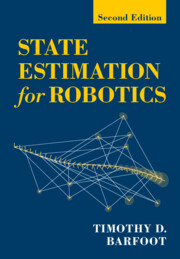Refine search
Actions for selected content:
1206 results in Computer Graphics, Image Processing and Robotics
Appendix C - Miscellaneous Extras
- from Part IV - Appendices
-
- Book:
- State Estimation for Robotics
- Published online:
- 11 January 2024
- Print publication:
- 01 February 2024, pp 471-483
-
- Chapter
- Export citation
9 - Pose Estimation Problems
- from Part III - Applications
-
- Book:
- State Estimation for Robotics
- Published online:
- 11 January 2024
- Print publication:
- 01 February 2024, pp 347-400
-
- Chapter
- Export citation
10 - Pose-and-Point Estimation Problems
- from Part III - Applications
-
- Book:
- State Estimation for Robotics
- Published online:
- 11 January 2024
- Print publication:
- 01 February 2024, pp 401-417
-
- Chapter
- Export citation
2 - Primer on Probability Theory
- from Part I - Estimation Machinery
-
- Book:
- State Estimation for Robotics
- Published online:
- 11 January 2024
- Print publication:
- 01 February 2024, pp 9-39
-
- Chapter
- Export citation
Part II - Three-Dimensional Machinery
-
- Book:
- State Estimation for Robotics
- Published online:
- 11 January 2024
- Print publication:
- 01 February 2024, pp 215-216
-
- Chapter
- Export citation
Frontmatter
-
- Book:
- State Estimation for Robotics
- Published online:
- 11 January 2024
- Print publication:
- 01 February 2024, pp i-iv
-
- Chapter
- Export citation
References
-
- Book:
- State Estimation for Robotics
- Published online:
- 11 January 2024
- Print publication:
- 01 February 2024, pp 501-508
-
- Chapter
- Export citation
Index
-
- Book:
- State Estimation for Robotics
- Published online:
- 11 January 2024
- Print publication:
- 01 February 2024, pp 509-514
-
- Chapter
- Export citation
Appendix A - Matrix Primer
- from Part IV - Appendices
-
- Book:
- State Estimation for Robotics
- Published online:
- 11 January 2024
- Print publication:
- 01 February 2024, pp 435-457
-
- Chapter
- Export citation
6 - Variational Inference
- from Part I - Estimation Machinery
-
- Book:
- State Estimation for Robotics
- Published online:
- 11 January 2024
- Print publication:
- 01 February 2024, pp 182-214
-
- Chapter
- Export citation

State Estimation for Robotics
- Second Edition
-
- Published online:
- 11 January 2024
- Print publication:
- 01 February 2024
2 - Bird’s–Eye View
-
- Book:
- Virtual Reality
- Published online:
- 12 October 2023
- Print publication:
- 02 November 2023, pp 31-54
-
- Chapter
- Export citation
6 - Visual Perception
-
- Book:
- Virtual Reality
- Published online:
- 12 October 2023
- Print publication:
- 02 November 2023, pp 129-154
-
- Chapter
- Export citation
10 - Interaction
-
- Book:
- Virtual Reality
- Published online:
- 12 October 2023
- Print publication:
- 02 November 2023, pp 245-270
-
- Chapter
- Export citation
11 - Audio
-
- Book:
- Virtual Reality
- Published online:
- 12 October 2023
- Print publication:
- 02 November 2023, pp 271-292
-
- Chapter
- Export citation
9 - Tracking
-
- Book:
- Virtual Reality
- Published online:
- 12 October 2023
- Print publication:
- 02 November 2023, pp 211-244
-
- Chapter
- Export citation
References
-
- Book:
- Virtual Reality
- Published online:
- 12 October 2023
- Print publication:
- 02 November 2023, pp 340-356
-
- Chapter
- Export citation
3 - The Geometry of Virtual Worlds
-
- Book:
- Virtual Reality
- Published online:
- 12 October 2023
- Print publication:
- 02 November 2023, pp 55-81
-
- Chapter
- Export citation
1 - Introduction
-
- Book:
- Virtual Reality
- Published online:
- 12 October 2023
- Print publication:
- 02 November 2023, pp 1-30
-
- Chapter
- Export citation
7 - Visual Rendering
-
- Book:
- Virtual Reality
- Published online:
- 12 October 2023
- Print publication:
- 02 November 2023, pp 155-184
-
- Chapter
- Export citation
